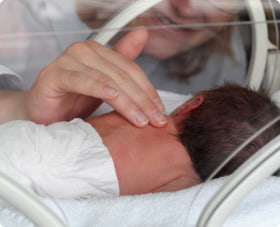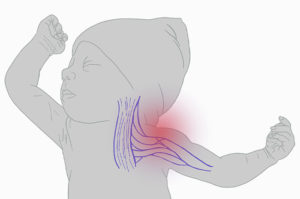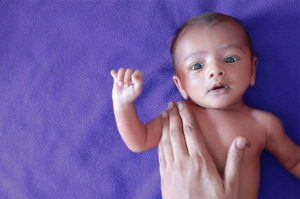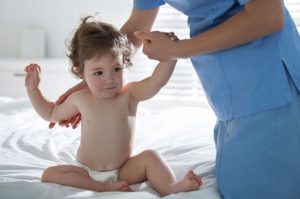What Is Erb’s Palsy?
 Erb’s palsy, also called brachial plexus birth palsy or Erb-Duchenne palsy, is a condition usually caused by nerve damage during childbirth.
Erb’s palsy, also called brachial plexus birth palsy or Erb-Duchenne palsy, is a condition usually caused by nerve damage during childbirth.
The brachial plexus is a network of nerves that sends signals from the spine to the shoulders, arms, and hands. Pulling or overstretching these nerves can cause Erb’s palsy.
Erb’s palsy commonly occurs during difficult deliveries. Symptoms can range from mild weakness to complete paralysis of the affected arm. While some cases resolve on their own, others may require physical therapy, surgery, or long-term care to restore function and mobility.
Treating Erb’s palsy can be expensive, with medical bills adding up quickly and unexpectedly. Families may also face expenses for adaptive equipment and lost wages due to caregiving responsibilities.
The Birth Injury Justice Center works with Erb’s palsy lawyers who have helped families nationwide recover over $1 billion from birth injury lawsuits, including those involving Erb’s palsy.
Find out if a top birth injury attorney can help you seek the financial compensation and justice your family deserves.
Get a free case review right now.
How Common Is Erb’s Palsy?
Erb’s palsy in newborns occurs in approximately 1 to 2 out of every 1,000 live births, according to the American Academy of Orthopaedic Surgeons.
It’s the most common among all brachial plexus injuries, typically involving damage to the upper nerves of the brachial plexus.
Erb’s palsy is more common in deliveries involving risk factors like shoulder dystocia. This medical emergency occurs when a baby’s shoulders become lodged behind the mother’s pubic bone.
Is Erb’s Palsy Preventable?
In many cases, Erb’s palsy is preventable with proper care during labor and delivery. When medical professionals use too much force, they can stretch or injure the brachial plexus nerves.
- Managing shoulder dystocia safely: Proper training can help delivery teams prevent excessive force on the baby’s neck and shoulders.
- Monitoring risk factors: Identifying conditions like high birth weight, maternal diabetes, or abnormal positioning can help prepare for delivery challenges.
- Reevaluating delivery techniques: Using methods like maternal repositioning or certain maneuvers in high-risk cases can reduce the risk of nerve injury.
Cesarean sections (C-sections) reduce some risks, but they do not completely prevent brachial plexus injuries. Even with the best practices, some injuries may occur due to factors beyond anyone’s control.
Erb’s Palsy Causes
The main cause of Erb’s palsy in babies is difficult deliveries, often due to medical negligence. Factors like shoulder dystocia, high birth weight, and prolonged labor can increase the risk.
- Abnormal maternal pelvis shape
- Birth weight over 8 pounds, 13 ounces (macrosomia)
- Gestational diabetes (high blood sugar during pregnancy)
- Maternal obesity
- Prolonged second stage of labor lasting over one hour
By using proper delivery techniques and monitoring the mother and baby during labor, medical professionals can reduce the risk of these injuries.
Can Medical Negligence Cause Erb’s Palsy?
Yes, medical malpractice can lead to preventable cases of Erb’s palsy. When health care providers apply excessive force or fail to address delivery complications safely, they risk causing brachial plexus nerve damage.
- Applying force to the baby’s shoulders during a head-first delivery
- Misusing delivery tools like forceps or vacuum extractors
- Using excessive pressure on the baby’s head or neck in difficult deliveries
- Pulling on the baby’s arms during a breech (feet- or buttocks-first) delivery
If your child has Erb’s palsy, and you suspect it may be due to medical negligence, we may be able to help.
Money from an Erb’s palsy lawsuit can mean your child getting the best possible care.
Get a free case review right now to see if you may qualify.
Types of Erb’s Palsy
There are several types of Erb’s palsy injuries. The type of brachial plexus injury a child develops can depend on the severity of damage to the nerve network.
Learn more about the common types of Erb’s palsy below.
 Neuropraxia
Neuropraxia
This is the most common type of Erb’s palsy involving nerves that are stretched but not torn, causing a stinging or burning sensation. Neuropraxias generally heal on their own in 3 months or less.
 Neuroma
Neuroma
More severe than neuropraxias, neuromas occur when scar tissue develops as nerves heal from an initial tear. This places pressure on healthy nerves. Most children with neuromas will only partially recover.
 Rupture
Rupture
This injury occurs when the nerve is torn. This type of injury does not heal on its own and generally requires nerve graft surgery to put damaged nerves back together.
 Avulsion
Avulsion
This is the most severe brachial plexus injury and occurs when the nerve roots are completely torn from the spinal cord, resulting in permanent muscle weakness or paralysis. Surgery can help repair torn nerves but cannot reattach them to the spinal cord.

Other Types of Brachial Plexus Injuries
There are other types of brachial plexus injuries besides Erb’s palsy that are less common. However, they often cause similar symptoms, like weakness or paralysis in the arm, and may benefit from the same treatment approaches, including physical therapy and surgery.
Other types of brachial plexus injuries include:
- Horner’s syndrome: This causes drooping eyelid (ptosis), smaller pupil (miosis), and reduced sweating (anhidrosis) on one side of the face.
- Klumpke’s palsy: This type of injury involves nerve damage in the lower arm and affects mobility in the hand and wrist.
- Total brachial plexus palsy: This condition involves nerve damage in both the lower and upper arm and causes complete paralysis in the affected limb.
Since these conditions have symptoms similar to those of Erb’s palsy, getting an accurate diagnosis from a doctor is crucial for effective treatment.
Erb’s Palsy Symptoms
There are several common signs and symptoms of Erb’s palsy. They can vary depending on how damaged the brachial plexus nerves are.
Common signs of Erb’s palsy include:
- Lack of muscular or nerve development in the arm or hand
- Limited ability to grasp objects or relying on one hand only
- Limp arm, wrist, or hand
- Muscle weakness in one arm
- Numbness or tingling in the shoulder, arm, or hand
- Partial or complete paralysis of the arm
- Waiter’s tip (arm hangs by the side with wrist rotated inward)
Early recognition of these symptoms is essential for timely diagnosis and treatment. If your baby is showing any of these symptoms, contact a health care professional for an evaluation.
How Do You Diagnose Erb’s Palsy?
 If you suspect your child has Erb’s palsy, you should consult your doctor or pediatrician. Only a medical expert can accurately make an Erb’s palsy diagnosis.
If you suspect your child has Erb’s palsy, you should consult your doctor or pediatrician. Only a medical expert can accurately make an Erb’s palsy diagnosis.
A doctor will conduct several examinations and imaging tests to diagnose brachial plexus palsy.
Common Erb’s palsy assessment tests include:
- CT (computed tomography) scan: This scan takes images from several angles of the body to search for damage to soft tissues, such as the brachial plexus.
- MRI (magnetic resonance imaging) scan: This scan takes images of the internal tissues in the body to look for brachial plexus nerve damage.
- Nerve conduction study: This physical test measures the speed of electrical impulses traveling through the brachial plexus nerves using electrodes.
- Physical examination: Doctors will look for any physical signs of nerve damage, such as muscle weakness and limited mobility of the arm, shoulder, wrist, or hand.
Your child’s doctor may use a combination of these tests to make an accurate diagnosis of Erb’s palsy.
“After a difficult delivery or shoulder dystocia, a nurse should quickly assess movement in the affected arm, comparing it to the unaffected side.”
— Katie Lavender, RN, Labor & Delivery
This immediate assessment helps identify potential nerve damage and ensures that appropriate care begins as soon as possible. Prompt intervention can significantly improve outcomes for children with Erb’s palsy.
Erb’s Palsy Prognosis
Once your child has been diagnosed, your doctor will give you a prognosis. An Erb’s palsy prognosis is the expected outlook of the condition. Thankfully, the overall outlook for brachial plexus palsy is generally very good.
Many babies with Erb’s palsy recover fully with proper treatment, but about 1 in 10 may require surgery between 4 and 9 months old, according to Johns Hopkins Medicine.
With prompt and proper therapy, mild cases of Erb’s palsy heal within a few months. However, severe cases may never fully heal, even with treatments like therapy and surgery.
Getting a prompt diagnosis is the best way to ensure your child can get effective treatment.
If you have questions about your child’s Erb’s palsy, we have on-staff registered nurses here to help. Connect with a nurse now — there’s no cost or obligation.
Erb’s Palsy Treatment
Treatment for Erb’s palsy focuses on improving mobility and strength in the affected arm. Mild cases of stretched nerves may only require physical therapy.
More severe cases of torn nerves may need intensive treatment and surgery to help the child regain mobility of their arm, hand, or shoulder.
With proper treatment, most babies with Erb’s palsy will recover completely within 12 months of age.
Erb’s palsy treatment in newborns often starts with physical therapy to prevent stiffness and encourage nerve recovery.
For older children, Erb’s palsy therapy may begin as soon as symptoms are identified to improve outcomes. Early intervention plays a crucial role in recovery.
Learn more about the most common types of Erb’s palsy treatment below.
Physical Therapy


Erb’s palsy physical therapy helps children improve strength, range of motion, and overall mobility. It is often one of the first steps in treatment to prevent joint stiffness and maintain muscle health.
These are 3 common elements of physical therapy for Erb’s palsy:
- Gentle stretching exercises: Preventing joint stiffness and maintaining flexibility
- Range of motion activities: Encouraging movement in the shoulder, elbow, and wrist
- Strength-building techniques: Improving muscle tone and function in affected arm
Physical therapy helps children regain movement and strength, supporting long-term recovery and improved arm function.
Occupational Therapy
Erb’s palsy occupational therapy focuses on helping children with Erb’s palsy develop fine motor skills, improve arm function, and perform daily tasks more independently.
Occupational therapists work with families to create tailored exercises and activities that support a child’s development.
- Adaptive equipment use: Introducing supports like an Erb’s palsy splint or brace to enhance mobility and function
- Fine motor skill development: Encouraging activities that improve hand and finger coordination
- Play-based therapy: Using games and toys to promote strength and dexterity in the affected arm
Occupational therapy provides children with the tools they need to manage daily activities and build independence.
Erb’s Palsy Surgery
Surgery for Erb’s palsy can repair damage to brachial plexus nerves that will not heal on their own, such as when there is a nerve tear. It is typically only used if your child does not show improvement despite other treatment options.
Nerve or tendon transfers remove healthy nerves from another part of the body to repair damaged brachial plexus nerves. Doctors may even decide to completely remove severely damaged nerve fibers that cannot be repaired.
Get Legal Help for Your Child’s Erb’s Palsy
Many cases of Erb’s palsy are caused by medical mistakes during delivery. Medical professionals who cause preventable birth injuries should be held accountable for their actions.
Your family should not be responsible for paying for your child’s Erb’s palsy treatment if the injury was preventable.
If medical negligence caused your child’s Erb’s palsy, you may be eligible for financial compensation. This money can help pay for treatments like Erb’s palsy surgery and therapy.
Our legal partners have secured over $1 billion for families affected by birth injuries like Erb’s palsy. We can help families in all 50 states and may be able to help your family, too.
Call (800) 914-1562 right now or get a free case review to see if you may qualify for compensation.
Erb’s Palsy FAQs
What is the cause of Erb's palsy?
Excessively pulling, stretching, or twisting the brachial plexus nerve network can cause a child to develop Erb’s palsy during the birthing process.
Discussing your child’s specific case with a trained medical professional can provide a clearer understanding of what caused Erb’s palsy.
We have on-staff registered nurses who can answer your questions.
Call us right now at (800) 914-1562 to get help — for free.
Can you sue for Erb's palsy?
Yes, you may be able to sue for Erb’s palsy if it was caused by medical negligence during childbirth. A legal claim can help families seek compensation for medical costs, therapy, and other expenses.
Understanding your legal rights is an important first step toward seeking justice and holding negligent medical professionals accountable.
Get a free case review right now to see if we can connect you with a top Erb’s palsy attorney near you.
Can you fully recover from Erb's palsy?
Full recovery from Erb’s palsy depends on the severity of the nerve damage. Mild cases often heal within weeks or months, especially with early intervention like physical therapy.
However, severe cases involving nerve tears or avulsions may require surgery and result in long-term limitations.
Erb palsy full recovery time varies, but for some, it may take years or remain incomplete despite treatment. Early diagnosis and consistent care improve the chances of better outcomes.
How can I give my child the best chance of a full recovery from Erb’s palsy?
The best way to help your child fully recover from Erb’s palsy is to get a prompt diagnosis and proper treatment.
The sooner your child is accurately diagnosed with Erb’s palsy, the sooner they are able to get treatment to manage their condition. Treatment focuses on helping the child regain strength and mobility in the affected arm in an effort to make a full recovery.
Is Erb’s palsy preventable?
It depends. Some cases of Erb’s palsy are caused by risk factors that may not be preventable. However, many cases are caused by medical mistakes during delivery.
Some medical professionals may use excess force during delivery, causing brachial plexus damage. In these situations, medical negligence may be to blame.
To find out if your child’s brachial plexus palsy may have been preventable, contact us today.
Is Erb’s palsy permanent?
Erb’s palsy is not always permanent. Mild cases often improve with therapy or on their own, while severe nerve damage may cause lasting limitations, even with treatment.
How is Erb’s Palsy treated?
Erb’s palsy treatment focuses on improving mobility and strength in the affected arm.
Common approaches include physical therapy, occupational therapy, and range-of-motion exercises to prevent stiffness and maintain muscle function.
In more severe cases, surgical options like nerve grafts, nerve transfers, or tendon transfers may be recommended. Early intervention is critical to achieving the best possible outcome.
What are the long-term effects of Erb's palsy?
The lasting effects of Erb’s paralysis depend on the severity of the nerve damage. Some individuals may experience permanent weakness and reduced range of motion in the affected arm.
In severe cases, full recovery may not be possible, leading to lifelong limitations in arm function. Early treatment, including therapy and sometimes surgery, can improve outcomes and minimize long-term impacts.
What is Erbs palsy compensation?
Erbs palsy lawsuit settlements provide financial compensation to families when the condition is caused by medical negligence. Compensation can help cover medical expenses, therapy, lost wages, and other costs associated with the injury.




